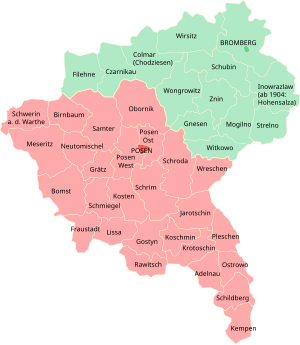Bromberg administrative district
The Prussian administrative district Bromberg was established in 1815 as a central authority for the administration of the northern Grand Duchy of Posen (later the Province of Posen ). During the time of the National Socialist occupation there was again an administrative district Bromberg within the Reichsgau Danzig-West Prussia from 1939 to 1945 .
location
The city of Bromberg was designated as the seat of government in 1815 . To the north, the district bordered the Marienwerder administrative district in the province of West Prussia . To the east was Russian Poland. In the south was the Poznan administrative district . To the west was the Frankfurt administrative district of the Brandenburg province .
structure
In 1820 the district consisted of the following districts:
- Bromberg
- Chodziesen (renamed Kolmar in Posen in 1877 )
- Czarnikau
- Gniezno
- Inowraclaw (renamed Hohensalza in 1904 )
- Mogilno
- Schubin
- We are seated
- Wongrowiec (renamed Wongrowitz in 1875 )
In 1875 Bromberg (previously the district of Bromberg) and in 1914 Schneidemühl (previously the district of Kolmar) were established in the city districts. The Strelno district was founded in 1886, and Filehne , Witkowo and Znin districts in 1887 .
geography
In 1820 the district covered about 11,697 km². Geographically, the area belonged to the north German lowlands. It was shaped by small lakes and swamps. Larger rivers were the Nets and the Brahe . The Vistula lay on the eastern border . The Bromberg Canal has connected the Vistula with the Elbe and Oder since the 18th century .
history
In Prussia
The administrative district Bromberg existed on the area annexed by Prussia in the course of the partitions of Poland . A large part of it fell under the provisions of the Versailles Treaty after the First World War to the Second Polish Republic .
In the Third Reich
After the occupation of Poland, an administrative district of Bromberg was set up again as part of the Reichsgau Danzig-West Prussia. It consisted of the city districts of Bromberg and Thorn and the districts of Bromberg, Culm , Schwetz , Thorn , Tuchel , Wirsitz and Zempelburg .
Population and economy
The population was 287,145 in 1820. It rose to 491,352 by 1850 and was 723,965 in 1905.
The main economic activity in the district was agriculture. Mineral resources were only extracted in small quantities. Industrialization was insignificant. In the first half of the 19th century, textile production at home was of certain importance.
traffic
The connection to the modern art streets began at the end of the 1840s. The first rail link to Szczecin and Posen was inaugurated in 1851. Further connections to Danzig and Königsberg as well as via Frankfurt an der Oder to Berlin followed. Later the railway and waterway network was expanded.
District President
- 1816: Joseph von Stein
- 1821: Kozierowski
- 1825: Ludwig von Colomb
- 1831: Carl von Wissmann
- 1842: Johann Eduard von Schleinitz
- 1848: Mebes ( representative )
- 1850: Julius von Schleinitz
- 1864: Schubring ( representative )
- 1864: Johann Gottlieb August Naumann
- 1870: Friedrich Maurach
- 1874: August von Seltzer-Stahn ( substitute )
- 1873: Anton von Wegnern
- 1881: Christoph von Tiedemann
- 1899: Theobald von Bethmann Hollweg
- 1900: Alfred von Conrad
- 1901: Francis Kruse
- 1903: Georg von Guenther
- 1917: Friedrich von Bülow
literature
- Official Journal of the Royal Prussian Government in Bromberg . Year 1827 ( online )
Web links
- Description on HGISG (PDF; 21 kB)
- District of Bromberg Administrative history and the district presidents on the website territorial.de (Rolf Jehke), as of August 25, 2013.
- Michael Rademacher: German administrative history from the unification of the empire in 1871 to the reunification in 1990. gau_danzig.html. (Online material for the dissertation, Osnabrück 2006).

